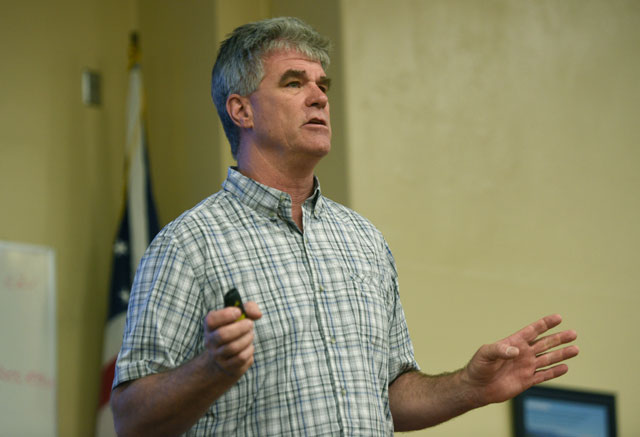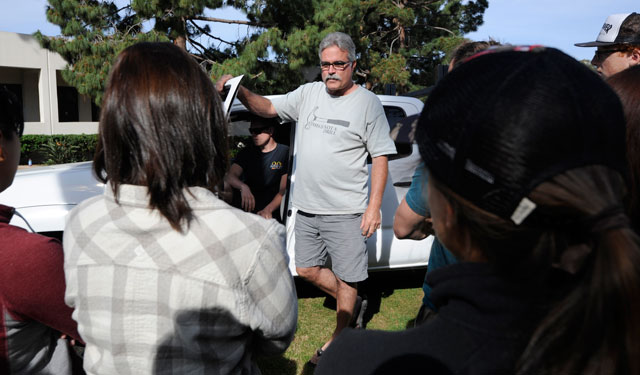
Their goal is to be the best part of the worst day of your life, and for the better part of the past three decades, Jack Franklin and Chris Mailes have worked to instill that same sense of purpose in their students. As the organizers and lead instructors of the emergency medical technician certification program at Santa Barbara City College, their formula has been simple: Be engaging, be funny, and exude passion for patient care.
“To keep 100 people at a time interested and passionate, I think we’ve done a good job of intertwining knowledge and entertainment,” Mailes said.
Every semester, the duo — both of them are veteran Santa Barbara County firefighters — teaches students of all ages the basics of emergency patient care: how to control bleeding, how to maintain an open airway, how to assess life-threatening medical conditions, and how to treat a host of other, often graver maladies. When the subject matter gets heavy, Mailes and Franklin lighten it up with jokes and catchphrases such as “death on a cracker” and “one foot in the grave and another on a banana peel.”

Their faux-acerbic old-married-couple comedy routine is the glue that binds together the various pieces of the class. Considering its source, their humor is a bit dark, but it maintains levity that keeps students’ spirits up as they go about learning how to save lives. Among first responders, the class is known affectionately as The Jack & Chris Show.
“They absolutely love what they do, and they share that in the classroom,” said Tyler Worley, a student from the most recent class. “Their stories are great and make it way more interesting.”
Standing in front of the class, the two burly, graying first responders are quick with a smile or a story about one or the other falling off a roof or doing something silly with power tools. They wear shorts and T-shirts, arrive in giant pickup trucks, and describe things that please them as “bitchin’.” Franklin says they’re like brothers and that they definitely hang out with one another outside of work and class.
But they have a serious side, too. The stories they tell, Mailes said, are all drawn from personal experience. Both he and Franklin — who, as they often like to point out, have known each other since before many of their students were born — began their careers as ambulance paramedics for American Medical Response.
“It’s not a dry EMT class,” Franklin said. “I try to bring up stories that teach people why you need to do things a certain way. If I’ve screwed something up, I can tell students about it. I’ve been a paramedic since I was 18.”
It’s difficult to nail down an exact figure, but by most estimates, anywhere from a third to a half of all public safety personnel in Santa Barbara County — including police officers, firefighters, park rangers, lifeguards, and so on — have been through Franklin and Mailes’s class at some point. Many students (myself included) have attended their recertification class every two years, for years and years.
“Without getting individual confirmation from each of the roughly 230 firefighters we have, it’s tough to come up with a precise number,” said Mike Eliason, the county fire department public information officer. “The anecdotal account of about a third to a half would be fairly accurate.”
By their own reckoning, they’ve taught about 4,000 students over the years. That’s 90 to as many as 140 students in a class each semester, plus 50-70 recertification students, over 27 years. It’s a lot of people to be sure, but perhaps more astounding is their reputation for answering individual emails and interacting with students on a one-on-one basis.
Of greater significance to the community at large is their students’ higher-than-average pass rate. The National Registry EMT exam is grueling. In addition to an exacting skills test (you lose points if you forget to check for scene safety or to verbalize assessed breathing and signs of circulation correctly, for example), most of the written exam questions have multiple answers that can be correct. But there’s only one best answer. The nationwide pass rate for the exam hovers around 70 percent, year after year. At City College, it’s typically in the mid-80s. But that may be because Franklin and Mailes set a high bar for students.
“I’m not going to tolerate a D or a C-minus,” Mailes said. “It’s in my best interest for students to do well in this class because I live in this community.”
There’s more to their method than the hard numbers of a tough certification exam. “Yes, they teach, but they also mentor,” Eliason said. “Not only do they impart the critical how-to knowledge of patient care to beginning students; they also relate the more intangible and important aspects of caring for a person who is at their most vulnerable.”
All kinds of people take Franklin and Mailes’s class, and many — although not all — aspire to medical professions. There are people who want to become cops and firefighters, but also doctors, helicopter medics, National Parks rangers, and even journalists and scientists.
“These people have gone all over the world to practice medicine, and it’s cool to know that I had a hand in their training,” Mailes said.
Closer to home, the emergency medical community is relatively small, so Franklin and Mailes run across their former charges with regularity. “It’s pretty hard to run a call and not see someone who was in our class,” Franklin said.
There are ambulance medics and firefighters, of course, but also nurses and doctors. Elizabeth Harris, who graduates from the physician assistant program at the Western University of Health Sciences on May 18, said that she took the City College EMT class to gain street-level medical perspective before becoming a P.A. “At the end of our last lecture, Chris read us The Ambulance Driver’s Perspective by Kelly Grayson,” she said. “It was such a powerful moment for me. I reference it often, especially when I need a little reminder as to why I entered into this field.”
Mailes says compassion is key to the profession, something he and Franklin relate in their lectures. He recalls an episode when his father — now deceased — was experiencing chest pain and needed emergency care. “Of the five EMT/paramedics that showed up at his house, four of them had been my students,” he said. “That’s how I teach my class — as if you are going to show up at my family’s house.”
All good things must come to an end.
Naturally, EMT course requirements have changed over the years. The class lengthened by 40 hours in 2012, and Mailes said additional hours may be added as patient care protocols continue to evolve. For the current academic year, City College signed a contract with Cottage Health System to beef up requirements for students who need to complete their obligatory emergency department observation hours in its hospitals. Among the new boxes that must be ticked off are drug testing, tuberculosis testing, and submission of childhood immunization records.
Both Franklin and Mailes concede that such information — along with the background checks that were already required — is good for the hospital to have. But the additional complex, changing standards have made Franklin and Mailes reconsider directing the course.
“We already revamped the course once, when it went from 120 hours to 160,” Mailes said. “It got to the point that I was like, ‘Well, it’s time to turn over the reins to someone more energetic who can bring something new to the class.’”
Neither he nor Franklin plan to stop teaching, but they both said they’d like to leave the heavy lifting to someone else so they can spend more time with their families. Cindy Bower, chair of the Allied Health department at City College, said that although their positions haven’t yet been filled, she hopes to hire their replacements by the start of the fall semester. She is, however, sorry to see the two veterans depart their leadership roles.
“They’re just a joy to work with, and I wish they were sticking around,” she said. “They’ve indicated that they’d still like to teach a little bit, but change is always challenging and bittersweet.”
Franklin said he hopes the institution can find someone good to take over the program.
“I have a strong affinity for this class,” he said. “I took it 37 years ago, and I love City College.”
Even with The Jack & Chris Show coming to an end, their impact upon the community will linger for years to come.
“They’ve formed the culture — especially the ethics and professional fidelity — of generations of emergency medical providers,” said Father Jon-Stephen Hedges, a Greek Orthodox minister who serves as chaplain to county EMS personnel and the county sheriff’s office. “Their legacy to the community is countless lives saved.”



